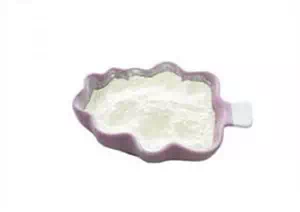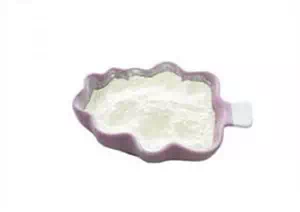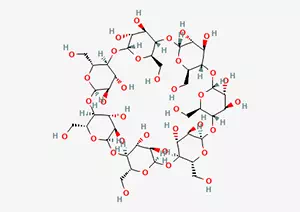In the vast world of chemistry, cyclodextrins, as a kind of distinctive compounds, have their unique and complex composition and wide applications. Cyclodextrins are a class of compounds carefully constructed by sugar molecules (specifically cyclic oligosaccharides) through a specific ring binding method. Its birth was not accidental but a wonderful result produced by a series of exquisite chemical transformation processes of starch.
Among this large family of cyclodextrins, α -cyclodextrins have emerged with their unique 7-membered sugar ring molecular form. This special structure endows it with numerous remarkable characteristics and uses.
In the important field of medicine that concerns human health, α -cyclodextrin plays an indispensable role. It is like a clever "assistant", playing an important role as a complexing agent. For those drugs with poor solubility in water, α -cyclodextrin can ingeniously combine with them, significantly improving the solubility of these insoluble drugs. This characteristic makes the absorption process of the drug in the body smoother, thereby effectively improving the bioavailability of the drug and enabling it to better exert its therapeutic effect. At the same time, it also acts as a solid "protective shield", enhancing the stability of the drug and making it less likely to become ineffective due to external factors during storage and transportation.
Not only that, α -cyclodextrin can also show its gentle side. It can ingeniously reduce the irritation of intestinal drugs to the intestinal mucosa, alleviating unnecessary pain for patients. Moreover, in the complex system of drug preparations, it can effectively prevent the interaction between drugs and drug excipients, ensuring the efficacy and safety of drugs.
In addition to shining brightly in the pharmaceutical market, the application scope of α -cyclodextrin has also been widely extended to multiple fields such as agriculture, ecological design, food, pharmaceuticals, drug distribution, and chemistry.
An in-depth exploration of the molecular structure of α -cyclodextrin will reveal its mystery. It is composed of a glucose system consisting of 7 α - (1-4) connected D-glucose units. This unique structure is like a meticulously designed "molecular edifice", with each glucose unit serving as the "cornerstone" of this edifice. They are interconnected through specific chemical bonds, forming a stable and orderly ring structure.
Cyclodextrin (usually abbreviated as Beta-Cyclodextrin β -CD) is actually the product of a series of complex reactions such as acid hydrolysis and cycination of starch. It has a magical ability, that is, it can precisely cover various compound molecules like a tailor-made "coat". When combined with the coating material, it can significantly enhance the safety of the coating material against external factors such as light, heat and oxygen, as if creating an impregnable "protective armor" for the coating material. Meanwhile, it also has the magical ability to change the physical and chemical structures of layered materials, further optimizing and enhancing the performance of the materials.
From the appearance, cyclodextrin appears as a white or semi-white crystalline or crystalline powder, giving people a pure and fine feeling. It is odorless and has no special smell. When you smell it gently, you can hardly detect anything unusual. And when you place it on the tip of your tongue, you will sense a faint sweetness. This subtle taste experience is also a manifestation of its unique chemical properties.
In terms of solubility, cyclodextrin exhibits distinctive properties. It can dissolve in water and seems like a lively "dancer" in it, capable of interacting well with water molecules to form a uniform solution. However, it is insoluble in organic solvents such as methanol, ethanol and acetone. This selective solubility property also provides convenience for its application in fields such as chemical separation and purification.
It is worth mentioning that cyclodextrin exhibits different stabilities in various solution environments. In alkaline solutions, it can maintain a stable structure, just like a tenacious "guard", holding fast to its "position". In acidic solutions, it undergoes hydrolysis reactions slowly, and this characteristic also provides controllable reaction conditions for it in some specific chemical reactions.
When cyclodextrin comes into contact with iodine, it presents a unique yellow color, which can also be used as a method to identify it. From the perspective of crystal morphology, its crystals are disc-shaped, and this regular shape is also an external manifestation of the orderly arrangement of its internal molecules.
More importantly, cyclodextrins have a strong ability to form inclusion complexes with numerous substances. The formation of this inclusion complex is like a wonderful "molecular wedding". Cyclodextrin combines with other substances, endowing the formed inclusion complex with a variety of excellent properties such as stability, solubilization, sustained release, emulsification, oxidation resistance, decomposition resistance, heat preservation, and moisture resistance. Moreover, it can also ingeniously mask unpleasant odors, making some substances that originally have a bad taste more acceptable. For this reason, it is hailed as a new type of molecular encapsulation material, providing new ideas and methods for the development and innovation in numerous fields.
β -nano-sponge based on cyclodextrin (β -cdn) has demonstrated outstanding performance and broad application prospects even on this basis. In the field of agriculture, it can provide better environmental conditions for the growth of crops and facilitate the efficient operation of agricultural production. In flower cultivation, it can protect flowers from the damage of the external environment and extend the freshness period of flowers. In the cosmetics industry, it can enhance the stability and efficacy of cosmetics, bringing more benefits to people's skin care. In the field of medicine, it provides a more precise and effective way for the delivery and release of drugs. It plays an important auxiliary role in the research and application of high-molecular-weight healthy proteins. In the research and development of new flame retardants, it is an indispensable component. In terms of gas supply, it can achieve more efficient and safe gas storage and transportation. It has also demonstrated unique advantages in the design of the new type of water filter array.
In recent years, with the continuous advancement of technology and the increasing demands for material performance, the field of advanced nanostructured systems based on cyclodextrins has developed rapidly. This is mainly attributed to its numerous advantages such as miniaturization, dose reduction, sustained release of energetic substances and controllable emission, as well as the long-term safety of the product. Among them, β -cdn, as a kind of colloid cross-linked nanoccarrier, has unique structural characteristics. It is composed of a strong network framework with nano-cavities. These nano-cavities are like tiny "storage rooms", capable of ingeniously encapsulating complex lipophilic and hydrophilic chemical substances, providing a stable storage and interaction environment for these substances.








